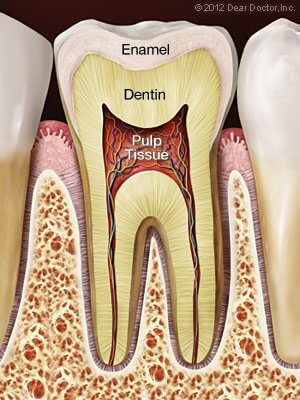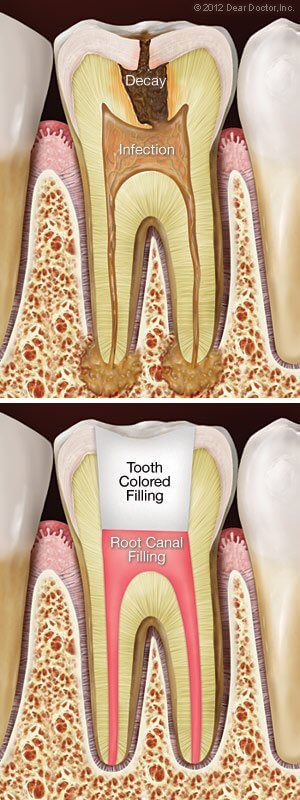
Endodontics is the dental specialty that deals with tissues and structures located inside the tooth. One of the most common endodontic treatments is root canal therapy, a procedure which effectively eases the pain associated with a bacterial infection deep within the pulp of the tooth. Of course, root canal treatment doesn’t just relieve pain — it also stops the infection by removing dead and dying tissue from the tooth’s pulp. Plus, it helps to save the tooth, which is in danger of being lost if left untreated. Yet root canal therapy isn’t the only treatment endodontics offers. This field also deals with cases of dental trauma, performs microsurgery on the tips of the tooth’s roots, and even helps figure out what’s going on when tooth pain seems to come and go intermittently, or when the pain isn’t localized at one tooth. So when it comes to preserving your natural teeth, endodontics has plenty of ways to help.
There’s so much that can be done these days to improve the appearance of a person’s smile — at any age. From powerful, professional whitening treatments to amazingly realistic porcelain veneers to state-of-the-art dental implants, there’s a wide range of exciting possibilities.
The first step in any smile makeover is a thorough dental examination to make sure that your cosmetic problems really are just that, and not a sign of underlying dental disease. Once your health has been established, your smile can be cosmetically enhanced in a variety of ways.
The Inside Story
Healthy Tooth. What’s inside your teeth? Behind the tough, shiny enamel of the tooth’s visible crown lies the sturdy inner tissue called dentin. Dentin is also found behind the cementum that forms the outer layer of the tooth’s roots — in fact, it makes up the bulk of the tooth’s structure. Similar in many ways to bone tissue, dentin is composed of many tiny tubules which can transmit sensations to nerve cells when it is stimulated. At the core of the tooth, inside small, branching chambers called the root canals, we find the soft pulp tissue. This consists of nerves, connective tissues and blood vessels which extend into the center of the tooth and exit through canals near the apex (tip) of the tooth’s roots. When problems (such as infection and inflammation) develop in the pulp tissue, your first indication of trouble may be tooth sensitivity — or intense pain. In time, as the nerves die, the pain may go away… but the problem won’t. In fact, if left untreated, the end result may be tooth loss.

The “Root” of the Problem
Root canal treatment. What could cause the pulp tissue to become diseased and lead to root canal problems? One potential source of infection is untreated tooth decay, which can allow bacteria from the tooth’s surface to work its way deep inside. A crack or fracture in a tooth could offer another pathway for microorganisms to infect the pulp.
Dental trauma — from a sports injury, for example — may also damage dentin or pulp, or expose it to infection. Extensive dental procedures (such as multiple fillings or restorations on the same tooth) may cause trouble; occasionally, even
Endodontic Treatment
The old gag line “I’d rather have a root canal” may still get a laugh — but root canal problems are no joke. It’s important to remember that root canal treatment doesn’t cause pain; it relieves pain. A typical root canal procedure is performed with local anesthetics, and doesn’t cause any more discomfort than having a filling. Here’s what to expect:
First, you will receive anesthesia (usually a numbing shot) — and for many patients, the worst is now over. Next, a small opening is made in the tooth surface to give access to the pulp chamber and root canals. Then, tiny instruments are used — often with the aid of a microscope — to remove dead and dying tissue from inside the narrow passages. These passages are then cleaned, disinfected, and filled with a safe, inert material. Finally, the opening in the tooth is sealed to prevent contamination.
Other endodontic treatments may be recommended for removing sources of infection and preventing future problems. Following an endodontic procedure, it may be necessary to have a restoration (such as a crown) placed on the tooth to restore it to full function and aesthetic appearance. After that, with proper care the restored tooth should last for many years.
At Inspire Dental, our endodontic services are designed to alleviate the discomfort that accompanies tooth pain and to preserve your natural smile. Endodontics, the dental specialty focused on the tissues and structures inside your teeth, plays a crucial role in maintaining oral health. One of the cornerstones of endodontic treatments is root canal therapy, a procedure specifically targeted towards treating tooth pulp infection and relieving pain caused by bacterial infections deep within the tooth.
Understanding when you may need root canal therapy is essential. Often, symptoms arise from untreated tooth decay, cracks or fractures in the tooth, or dental trauma. Ignoring these signs can lead to severe pain, tooth sensitivity relief issues, or even tooth loss. The compassion our team showcases during treatment is paired with our commitment to providing exceptional dental care, especially for those with special needs.
Root canal therapy is not just a treatment; it is a pathway to alleviating the throbbing ache of a tooth that has been compromised. When the soft tissue inside your tooth—the pulp—becomes infected or inflamed, it can cause significant discomfort. Our skilled team will conduct a thorough assessment to diagnose the specific issues affecting your tooth. Utilizing local anesthesia in dentistry, we ensure that your experience is as comfortable and pain-free as possible.
The root canal procedure begins with creating a small opening in the tooth to access the pulp. Through this opening, we’ll remove the infected tissue using specialized instruments. This meticulous process ensures that all diseased pulp tissue is eliminated, effectively stopping the infection at its source. Once the cleaning and disinfecting of the canals are complete, we fill them with an inert material to provide stability and prevent future issues. Finally, we seal the opening of the tooth to restore its strength and function.
After root canal therapy, many of our patients express tremendous relief as their tooth sensitivity subsides and their tooth pain treatment goals are met. We also emphasize education on tooth anatomy because understanding the anatomy of a healthy tooth—including its enamel, dentin, and pulp—can empower you to maintain your oral health effectively. Our team at Inspire Dental believes patient-centered dental care starts with knowledge.
In addition to root canal therapy, our endodontic services also address complex cases of dental trauma. Whether you have suffered an injury or a sudden dental emergency, our emergency dental services are readily available to ensure prompt intervention. We understand that a dental emergency can be distressing, and our compassionate dental care approach is tailored to ease your concerns while providing effective solutions.
Our commitment to comprehensive dental care extends beyond endodontics. Inspire Dental proudly offers a variety of cosmetic dentistry services aimed at enhancing your smile. Whether you’re considering dental implants, veneers, or other cosmetic dental procedures, our team is here to guide you every step of the way. The intersection of restorative and cosmetic work not only improves aesthetics but also strengthens your overall dental function.
Moreover, we recognize that dental care accessibility is critical for many families, including those seeking financing options for dental treatment. At Inspire Dental, we provide flexible financing solutions like CareCredit, ensuring that all patients, including those with special needs, have access to the dental services they require without financial stress. We believe that quality dental care should be attainable to everyone in our community.
Inspire Dental is also committed to continuous education and outreach. Understanding the complexities of dental care, we actively engage in research and community initiatives to promote oral health. Through studies and trials, we are informed about the best practices and innovative approaches in dentistry. For instance, recent research highlighting the importance of addressing dental anxiety aligns with our goal of offering a calm and reassuring environment, making us your trusted dental partner.
Furthermore, our focus on special needs dental care ensures that every individual is met with respect and understanding. Our experienced team is trained to provide a welcoming atmosphere tailored to the specific needs of patients, helping to break down the barriers that often impede access to dental services.
In choosing Inspire Dental for your endodontic needs, you're entrusting your oral health to a dedicated team that prioritizes your comfort and well-being. Our blend of advanced techniques and compassionate dental care makes us leaders in root canal therapy and beyond. Whether you’re in need of emergency care, tooth pain treatment, or simply exploring cosmetic dental options, we are here to assist you.
In conclusion, if you are experiencing tooth sensitivity, persistent pain, or suspect a dental emergency, do not hesitate to reach out. Our team at Inspire Dental is ready to provide superior endodontics services and support you on your journey to achieving optimal dental health. Together, we can ensure that your smile remains bright and healthy for years to come. Your comfort is our priority, and exceptional dental care is our promise.
